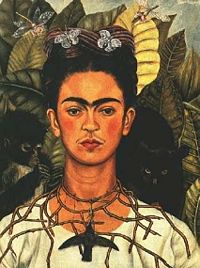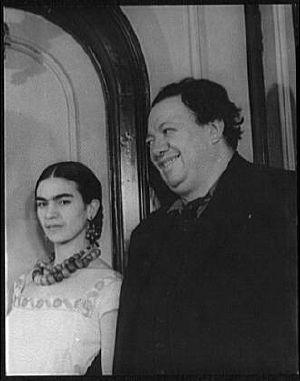Frida Kahlo
Magdalena Carmen Frida Kahlo y Calderón de Rivera, better known as Frida Kahlo (July 6, 1907 to July 13, 1954), was a Mexican painter of the indigenous culture of her country in a style combining Realism, Symbolism and Surrealism. She was the wife of the Mexican muralist and cubist painter Diego Rivera.
Kahlo's life was one marked by suffering, heroism, and genius. Stricken with polio as a child, then nearly crippled in a bus accident at the age of eighteen, Kahlo defied the odds, not only by learning to walk again, but by taking the world by storm with her unique artistic vision.[1]
During her life, Kahlo was recognized primarily by the intellectual elite, both in Mexico and internationally, but was not well known among ordinary Mexicans, particularly because she worked in mediums that did not lend themselves to mass distribution. [2]
A child during the Mexican Revolution, Kahlo grew up in an era of social change. In the 1920s Frida espoused a Communist, anti-capitalist, philosophy, She befriended the famed Bolshevik revolutionary and Marxist theorist, Leon Trostky, who was assassinated in her home country of Mexico.
Known for her unconventional appearance and flamboyantly styled clothing, Ms. Kahlo accomplished much in her short tragic life. She was a surrealist artist who expressed her inner self through her paintings. To the public she was a high spirited rebellious woman. Her creative style was breathtaking yet bewildering. Frida was probably the most idolized woman artist of her time. Today, she is a figure of legendary power whose work inspires excitement and awe throughout the world. [3]
Family and Childhood
Kahlo was born Magdalena Carmen Frieda Kahlo y Calderón in her parents' house in Coyoacán, which at the time was a small town on the outskirts of Mexico City.
Heritage
Frida's father, of Hungarian Jewish descent, was born Wilhelm Kahlo in Baden-Baden, Germany, in 1872. At the age of nineteen he moved to Mexico City and began a new life by changing his name to its Spanish equivalent - Guillermo. He never returned to Germany.
In 1898 Guillermo married Matilde Calderon, a woman of Spanish and Native American descent. Frida was the third of four daughters born of their marriage. [4]
Frida later claimed she was born in 1910 in order to affiliate herself further with being a product of the Mexican Revolution, which began in 1910. [5]
Health
Kahlo's life was marked by tragedy. At the age of 7 she was stricken with polio and was left with one leg being smaller and thinner than the other. Still, with her father's encouragement and with the feisty and brash personality that she kept throughout her life, she overcame her disability.
At the age of 18 Kahlo was involved in a horrendous streetcar - bus accident. Not only was her lower body impaled on a metal rod, she broke her collarbone, her pelvis, several ribs and also her spine in three places. Her right leg had eleven fractures and her right foot was crushed and dislocated. For the second time in her life, she had to re-learn to walk.
Throughout her life she was plagued by relapses of extreme pain, often leaving her hospitalized and/or in bed for months at a time, agonized and miserable. Frida would undergo as many as thirty-five operations in her life as a result of the accident, mainly on her back and her right leg or foot.
During her life she suffered three miscarriages, thought to be caused by her prior injuries. Later in life she developed more severe complications and suffered a gangrenous leg, which had to be amputated. [6]
Casa Azul
Frida Kahlo was born, lived, and died in her Casa Azul (Blue House) in Coyoacán, Mexico. The valley of Mexico is very fertile, therefore her house was filled with flora, trees, and cacti. [7]
A cheerful home populated by pre-Columbian idols and luxuriant tropical plantings, painted inside and out in cobalt blue with bright yellow floors, the family home provided a cheerful backdrop for a child with much physical suffering. This is the home where she was born, grew up and later lived with her husband Diego Rivera, from 1941 until her death at age 47 in 1954.
At Frida's death in 1954, Rivera gave the Casa Azul and its contents to the Mexican people, it opened as a museum four years later. Now known as the Frida Kahlo Museum, this bit of pure Mexicanista is hidden behind high cobalt blue walls in a charming southwestern suburb of Mexico City, Ms. Kahlo's birthplace. [8]
The Adult Frida
It is impossible to study Frida Kahlo's artistry, marriage, morals and politics in separate veins. These aspects of her life were intricately intermingled, each affecting the other.
Kahlo the Artist
During Kahlo's long recuperation from the bus accident, she discovered her love for painting. Using a lap easel her mother gave her and a mirror she'd had hung in the canopy above her bed, Kahlo produced some of her earliest self-portraits. [9]
Before this time, Kahlo had planned on a medical career, but gave it up for a full-time career in painting. Drawing on her personal experiences such as her troubled marriage, her painful miscarriages and her numerous operations, her works are often shocking in their stark portrayal of pain.
Fifty-five of Kahlo's 143 paintings are self-portraits, often incorporating symbolic portrayal of her physical and psychological wounds. She was deeply influenced by indigenous Mexican culture, which surfaced in her paintings' bright colors, dramatic symbolism, and unapologetic rendering of often harsh and gory content.
Frida, the person and her art, defy easy definition. Rather, they lend themselves to ambiguous description. Often volatile and obsessive, Frida was alternately hopeful and despairing. [10] Although her work is sometimes classified as surrealist, and she did exhibit several times with European surrealists, she did not consider herself one. "They thought I was a Surrealist, but I wasn't. I never painted dreams. I painted my own reality." she once said.
Like much of Mexican art, Frida's paintings "interweave fact and fantasy as if the two were inseparable and equally real," Hayden Herrera, her principal biographer stated. [11]
Her preoccupation with female themes and the figurative candor with which she expressed them made her something of a feminist cult figure in the last decades of the 20th century, though she was little known outside the world of art until the 1990's.
Marriage and Morals
Despite her life of suffering and pain, Frida Kahlo was a vibrant, extroverted character whose everyday speech was filled with profanities. She had been a tomboy in her youth and carried her fervor throughout her life. She was a heavy smoker, drank liquor (especially tequila) in excess, was openly bisexual, sang off-color songs, and told equally ribald jokes to the guests of the wild parties that she hosted.
Politics
Legacy
External links
Frida Kahlo
- The Life and Art of Frida Kahlo
- "The Frida Kahlo Museum", by Gale Randall
- Exhibition guide from Tate Modern
- Frida's House Yahoo! group
- "Frida Kahlo & contemporary thought"
- "Frida by Kahlo"
- "Frida Kahlo" at ArtCyclopedia
- Frida (2002 film) at the Internet Movie Database
- (Spanish) "Dolor y arte: Frida Kahlo" from Psikeba Magazine
- Ten Dreams Galleries
- Photos
Credits
New World Encyclopedia writers and editors rewrote and completed the Wikipedia article in accordance with New World Encyclopedia standards. This article abides by terms of the Creative Commons CC-by-sa 3.0 License (CC-by-sa), which may be used and disseminated with proper attribution. Credit is due under the terms of this license that can reference both the New World Encyclopedia contributors and the selfless volunteer contributors of the Wikimedia Foundation. To cite this article click here for a list of acceptable citing formats.The history of earlier contributions by wikipedians is accessible to researchers here:
The history of this article since it was imported to New World Encyclopedia:
Note: Some restrictions may apply to use of individual images which are separately licensed.


